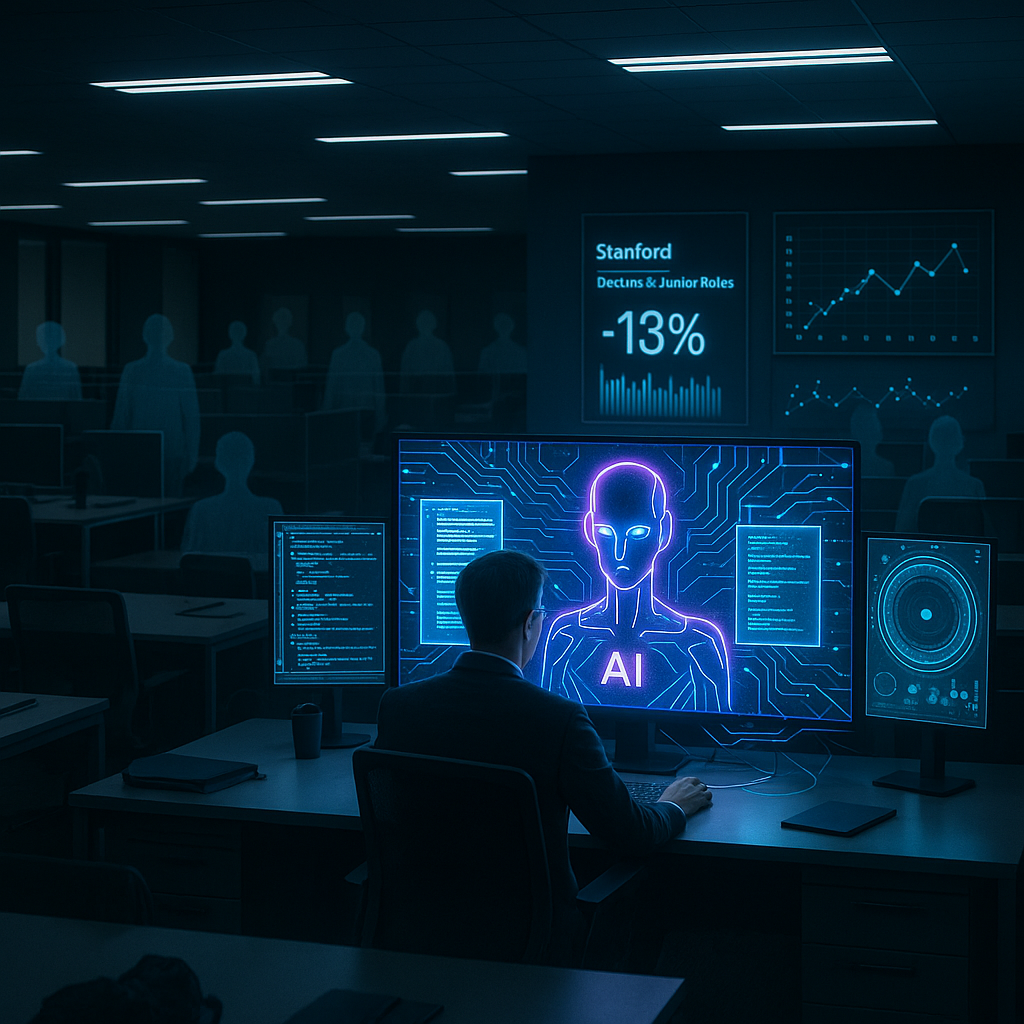Key Takeaways
- Stanford research reveals AI-driven automation has cut 13% of junior roles, marking a critical shift in how human contribution is valued in increasingly AI-centric workplaces.
- The pace of AI adaptation is accelerating, with heightened institutional scrutiny and significant global repercussions.
- Top story: AI automation’s 13% reduction of junior jobs raises questions about conventional career paths and the long-term value of entry-level positions.
- Meta’s Llama AI is being adapted for US military use—reflecting the evolving interplay between civilian and defense technology.
- Google’s Gemini model processed 5 billion images in less than a month, illustrating the scale and ethical challenges of machine vision.
- The UN Security Council has brought AI’s potential societal threats to the forefront, prompting urgent discussions around philosophical and regulatory responsibilities.
- These developments encourage a deeper examination of the forms of intelligence society is nurturing alongside human ingenuity.
Introduction
On 27 September 2025, new research from Stanford highlighted a turning point in employment as AI-driven automation led to the elimination of 13% of junior jobs. This transformation is compelling organizations and workers to reassess the value of human roles in an era dominated by intelligent machines. Meanwhile, Meta’s Llama project shifts toward national security operations, reflecting the evolving dynamics among innovation, authority, and society’s relationship with artificial intelligence.
Top Story
Stanford Study: AI Automation Cuts 13% of Junior Jobs in Information Work
Stanford University researchers reported a 13% decline in junior information roles following widespread AI adoption, based on data from a three-month study of 5,000 knowledge workers. The study documented disruptions in content creation, data analysis, and project management, especially where AI tools had become integrated into daily tasks.
Key findings show 78% of participants relied on AI assistants for activities ranging from document summarization to code review. Technical documentation, market research, and software development roles experienced the highest impacts.
Industry experts interpret these findings as evidence of an evolving, hybrid workforce where human and artificial intelligence are increasingly interdependent. Dr. Sarah Chen, lead researcher at Stanford’s Institute for Human-Centered AI, stated that a new model of collaborative workflows is emerging as a result.
Stay Sharp. Stay Ahead.
Join our Telegram Channel for exclusive content, real insights,
engage with us and other members and get access to
insider updates, early news and top insights.
 Join the Channel
Join the Channel
Also Today
Security and Governance
EU AI Act Faces Implementation Challenges
European regulators have announced revised schedules for the AI Act as a result of technical hurdles in defining “high-risk” systems. The European Commission’s AI Office confirmed a phased approach, starting 15 December 2025.
Tech industry stakeholders have raised concerns regarding compliance costs, with a consortium estimating €2.4 billion in implementation expenses across the EU. The Commission emphasized that robust safeguards are necessary for responsible AI development.
International Standards Push
The International Standards Organization (ISO) released new framework recommendations for global AI governance, reflecting collaboration among 45 countries. The standards prioritize transparency, accountability, and human oversight.
Innovation and Research
Quantum-AI Integration Achieved
Researchers at ETH Zurich demonstrated practical integration between quantum computing and traditional AI algorithms. Their work, published in Nature Quantum Computing, achieved a 40% performance boost for complex optimization problems.
This advancement combines quantum features for targeted computational tasks while maintaining compatibility with current AI frameworks. Dr. Marcus Weber, the project lead, noted the potential for significant gains in certain machine learning applications.
Open-Source AI Infrastructure Expands
The Linux Foundation’s AI Commons initiative gained 12 new corporate contributors, aiming to standardize infrastructure for AI development and deployment across industries.
What to Watch
- 2 October 2025: Stanford Research Team to present detailed findings at the World AI Summit in Geneva.
- 15 October 2025: EU Commission technical group meets to finalize AI Act implementation guidelines.
- 21 October 2025: ISO AI Governance Standards formal ratification meeting in Brussels.
- 1 November 2025: Linux Foundation AI Commons developer conference in San Francisco.
Conclusion
Stanford’s findings underline a major transformation as AI automation reshapes junior-level knowledge work, prompting organizations to reassess the balance of human expertise and machine collaboration. The intersecting developments—from Meta’s military AI initiatives to EU regulatory hurdles and pioneering advances in quantum-AI integration—emphasize the need for responsible adoption. What to watch: Detailed Stanford results at the World AI Summit on 2 October, and key EU and ISO meetings shaping the future of AI governance.





Leave a Reply